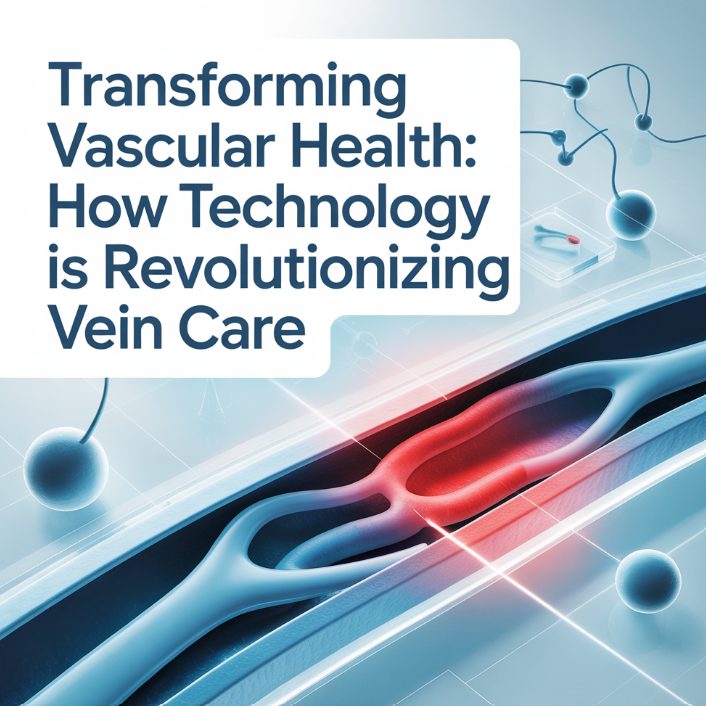
@ShahidNShah


The profile of vascular health has been transformed radically in recent decades; the engine driving this is technology. I hope that clears up some of the misconceptions! From non-invasive vein treatments to enhanced diagnostic imaging, medicine has changed the playing field by making it safe and easy to perform many of these procedures in an office setting, all with virtually very little down downtime. In the past, varicose veins, spider veins, and chronic venous insufficiency all meant developing serious surgeries with long recoveries. Today, advancing technology has not just enhanced results but also the lives of patients, who can now play a major role in managing their circulatory wellness. Vein care has never been closer to its future, driven by precision, personalization, and advancement.
Vein conditions were typically treated with invasive procedures, involving general anesthesia and inpatient care, and a significant time spent recovering from the surgery. Old-fashioned vein stripping, for instance, entailed the actual extraction of damaged veins and so was painful and liable to complications. But this sector has been completely disrupted with the entry of tech-based solutions. Today, treatments are mostly outpatient, with patients returning to their usual routine within hours. We have since added ultrasound imaging, catheter-based therapies, and laser energy, with surgery no longer being necessary. These advancements have taken vein care to a new level of expediency and ease, lightening the physical and emotional load on treatment.
Among the several technical revolutions in vascular medicine, the development of diagnostic imaging is perhaps one of the most important. Contemporary ultrasound imaging gives doctors a live look at the veins beneath the skin, so they can make an accurate diagnosis and treatment plan. Doppler ultrasound, in particular, can detect blood flow in the veins and find any points of reflux or obstruction that may not be noticeable to the naked eye. This non-invasive imaging has quickly become the foundation for effective vein care, as it allows professionals to identify diseased veins before they develop into more serious health problems. It’s this level of specificity that the Vein Clinic in Edmonds is employing to develop personalized treatment plans for everybody with a unique vascular diagnosis.
Among the treatments revolutionizing vein care, endovenous laser therapy (EVLT) has to be up there with the best. The procedure applies laser energy to specific veins in the hope of shutting them down and redirecting the blood flow to functional veins. Unlike past treatments, EVLT is done using local anesthetic, involves a tiny incision, and causes little scarring. It is a rapid and efficient procedure, which has success rates of greater than 95% in the majority of patients. Laser offers accuracy, only the damaged vein is being treated, meaning less damage to surrounding tissues. This development has already helped thousands of patients find relief from pain, swelling, and discomfort – without the potential danger and downtimes of a more invasive surgery.
There is another landmark technological development in contemporary vein management, and it is the introduction of RFA. Just like laser treatment, RFA closes problem veins with heat; however, the level of heating of RFA is easier to control, and thermal energy must be administered at a much lower temperature than that of laser therapy. EVLT and RFA have greatly enhanced the lives of those suffering from chronic venous insufficiency by providing results that last for years with very little downtime for recovery. Both foam sclerotherapy and glue vein closures have advanced as alternatives to the above-mentioned procedures. What all of this choice means is that vein specialists can now customize care, according to disease severity, the patient’s general health, and when healthy lifestyle preferences play a role, once an impossible feat in the days of traditional vein surgery.
Artificial intelligence (AI) is on its way to becoming a robust partner in maintaining vascular health. AI-based tools can analyze medical images, identify patterns, and anticipate impending issues well before patients feel sick. For instance, machine learning software is in development to discern small changes in vein structure or blood flow that might signal early stages of venous disease. Predictive analytics can also enable doctors to customize treatment plans and better track progress. With such a data-driven approach, let alone faster, the diagnosis has a higher success rate of treatment. AI will increasingly be used to prevent vein problems from happening, so we can address issues such as deep vein thrombosis or venous ulcers before they take hold.
In the digital health era, wearable devices have revolutionized the way that people monitor and take care of their circulatory health. Fitness trackers, smartwatches, and other health monitors can now measure heart rate, blood oxygen levels, and even fine differences in circulation. For those susceptible to venous conditions, such technologies provide critical information on daily routines, fitness, and general vascular fitness. This means wearables data can be shared with healthcare providers in real time, allowing a conduit between the patient and their healthcare provider. With this kind of regular observation, it not only increases early detection but is also a good reminder to motivate people to move more and make lifestyle changes that are healthier for their veins.
Leading the way in technological breakthroughs is that of personalized vein care. No two patients are identical in terms of vein planes or health status, and technology today means we can create treatments that cater to each patient’s unique requirements. With advanced imaging and mapping, doctors are able to see clear images of each patient’s unique anatomy before an intervention is planned. Pooled with the minimally invasive techniques, it allows for quicker recovery, fewer complications, and improved aesthetic results. Establishments such as the Vein Clinic in Edmonds are examples of how personalized care can be up with state-of-the-art technology to change patients’ lives.
Not only has technology transformed the way that doctors treat, but patients are also how they’re engaging with their own health. Online preparation, telemedicine, and educational resources are hitting all-time highs for patients to learn about vein health, schedule consultations, and receive after-visit care from the convenience of their homes. This heightened accessibility enables patients to be proactive in the management of their vascular health. In only a few steps, someone can now see specialists, receive diagnostic reports, and follow up on their recovery process. The result is a more educated and engaged group of patients, who are contributing to improved vascular outcomes.
Another phenomenal benefit of technological evolution in vein care is sustainability. Less invasive interventions use fewer resources, produce less medical waste, and have a reduced environmental impact in healthcare. Moreover, technological efficiency means that treatments are carried out quickly and with less energy and materials. This reflects the increasing international focus on providing sustainable healthcare systems, taking into account both patient health and ecological responsibility. By combining technology and sustainability, the future of vein care will be more than just more effective- it’s also going to be ethical, sustainable, and eco-conscious.
Vein care has come such a long way — from invasive surgeries with downtime to precise, tech-powered treatments that value comfort, accuracy, and long-lasting results. Contemporary technology has changed the way we diagnose, treat, and prevent venous diseases and provided patients with a new standard of care that is minimally invasive, evidence-based, and individualized. From advances in imaging and AI-driven analytics to wearable technology that boosts day-to-day awareness, the discipline of vascular medicine is moving at breakneck speed. For those in search of leading-edge experts and cutting-edge procedures, the Vein Clinic in Edmonds stands as an example of how advanced medical care and warm, personalized attention can go together. As we consider the future, it’s obvious: technology is no longer just about vein care – it is providing us with healthier, stronger, and more confident lives at every heartbeat.

Modern medicine continues to evolve, but few areas have advanced as rapidly as surgical precision. Technology has reshaped the way doctors plan and perform operations, improving accuracy, safety, and …
Posted Oct 28, 2025 Healthcare Innovation Healthcare
Connecting innovation decision makers to authoritative information, institutions, people and insights.
Medigy accurately delivers healthcare and technology information, news and insight from around the world.
Medigy surfaces the world's best crowdsourced health tech offerings with social interactions and peer reviews.
© 2025 Netspective Foundation, Inc. All Rights Reserved.
Built on Dec 16, 2025 at 1:07pm